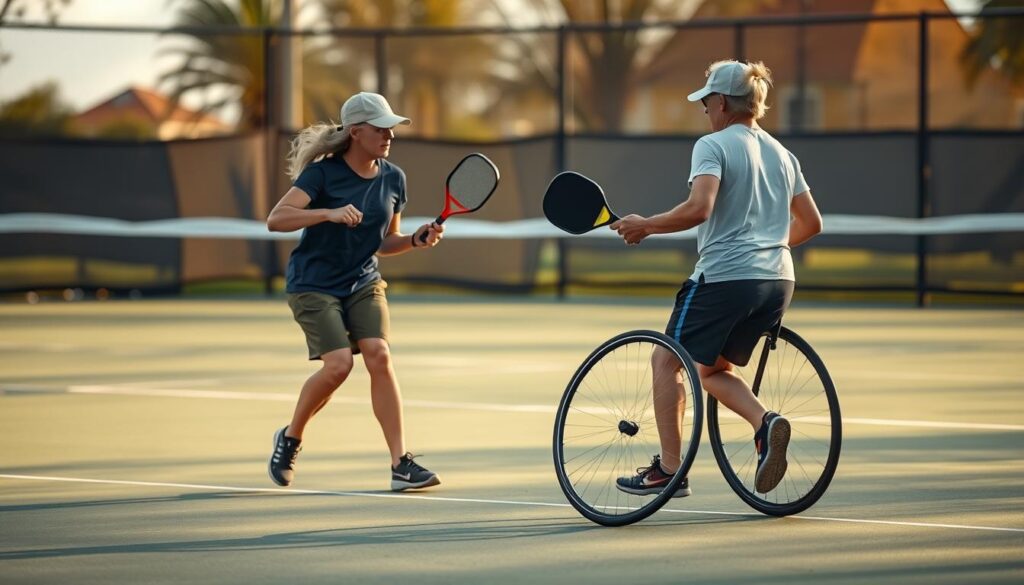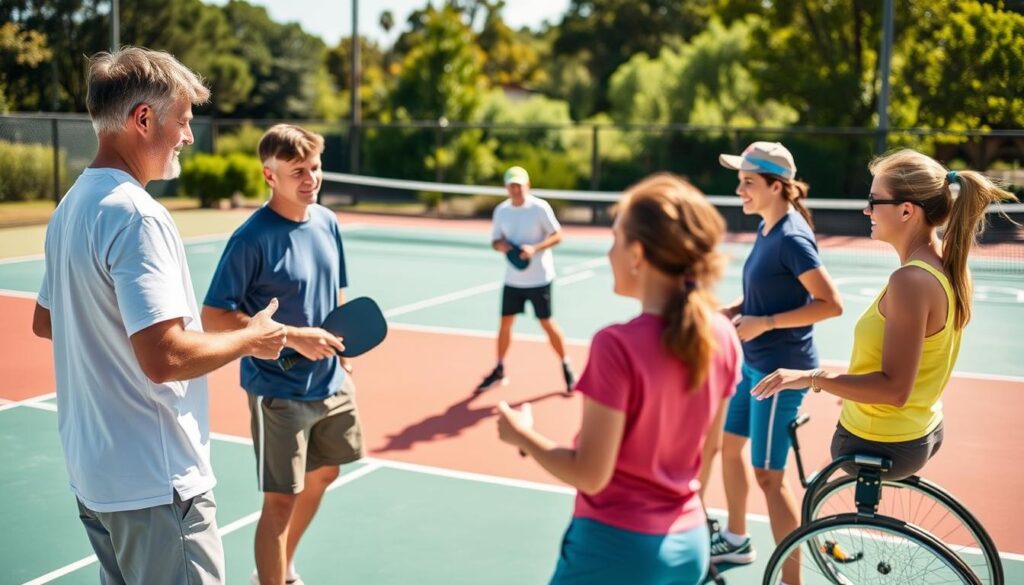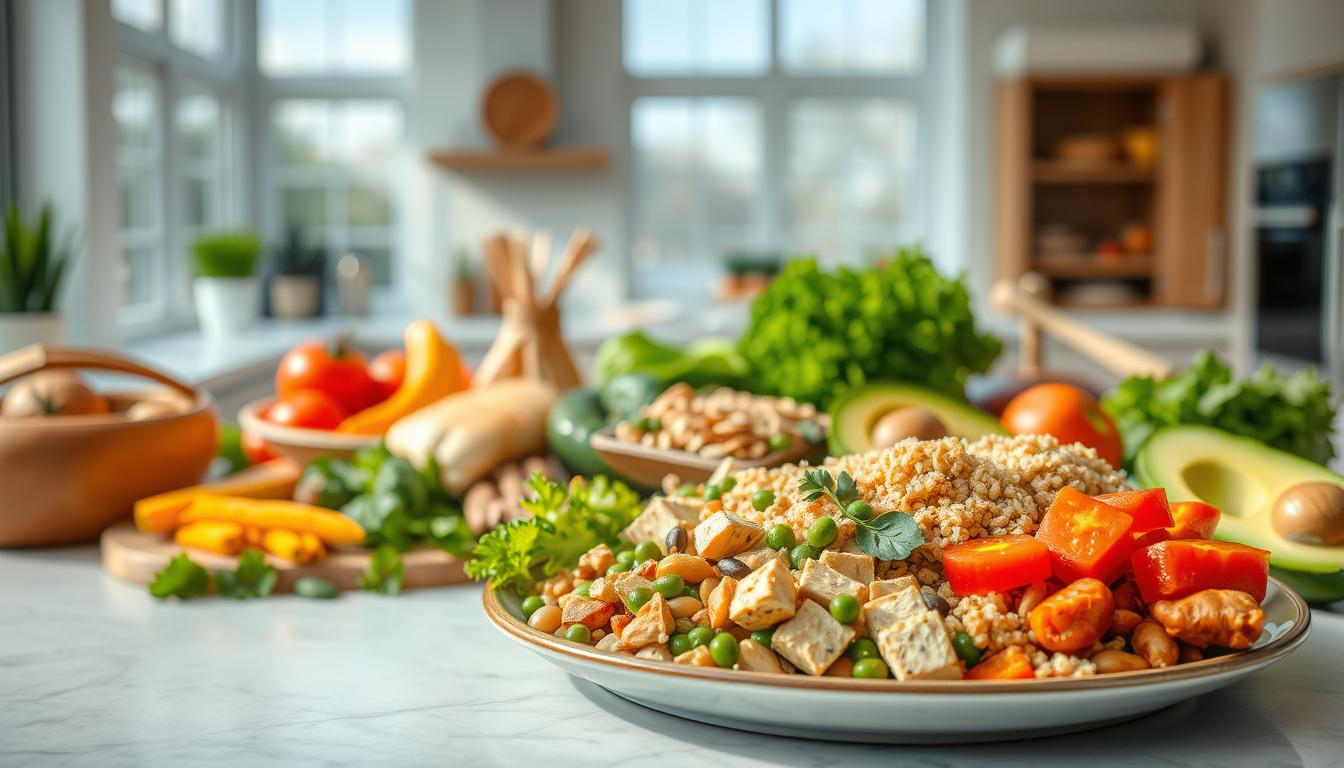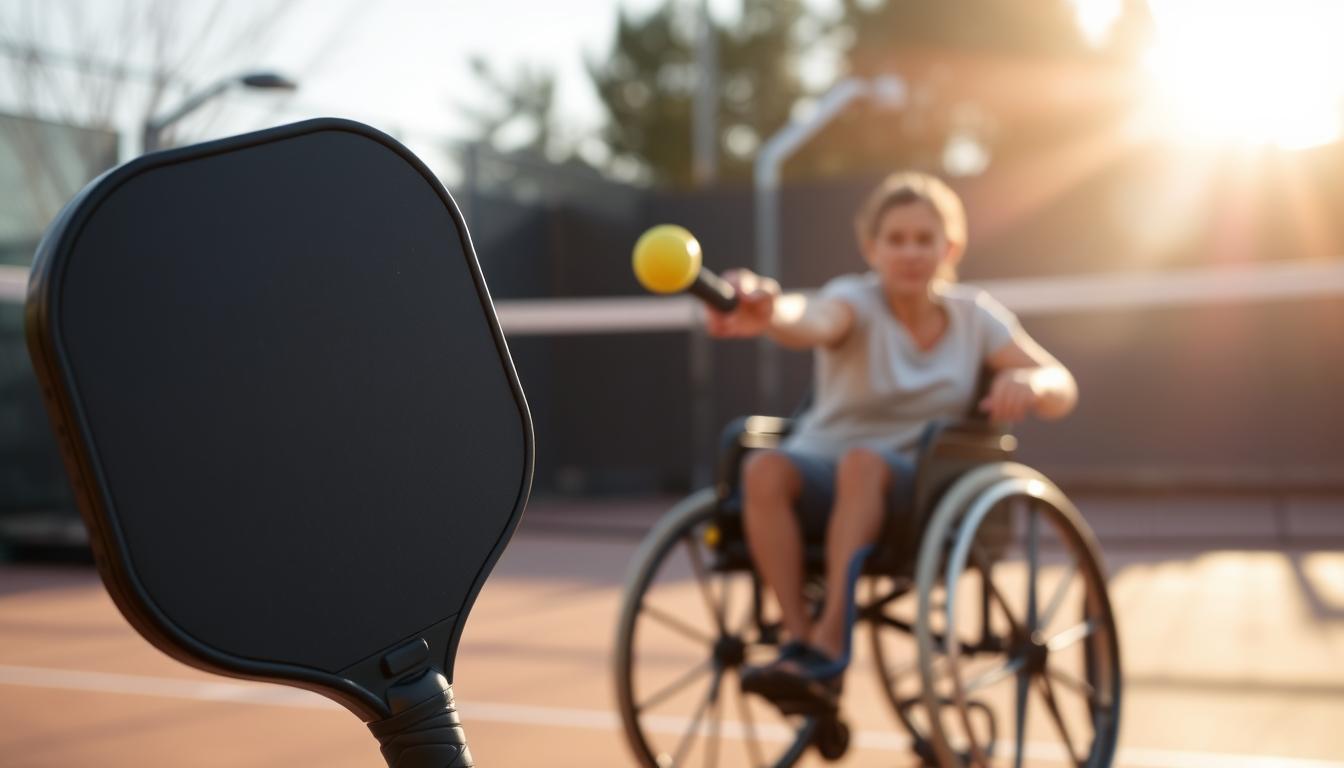What if you could play a fast-paced game like pickleball, no matter your physical abilities? Adaptive pickleball makes this possible, welcoming players with limited mobility. It turns the sport into an inclusive experience for all.
By using modified rules and techniques, pickleball drills help everyone participate. This way, everyone can enjoy the game and grow both socially and physically. Let’s dive into the world of adaptive pickleball, where every game is a chance to connect and have fun.
What is Adaptive Pickleball?
Adaptive pickleball is a special version of the game for people with different disabilities. It lets players, with or without wheelchairs, fully enjoy the game. This version makes sure everyone can play, no matter their physical or sensory abilities.
It has rules and changes that make it easier for everyone to play. This is key for promoting sports for people with disabilities. The game’s core remains the same, but it’s made more accessible. This way, everyone can enjoy the fun, physical activity, and social benefits of pickleball.
Understanding the Rules of Adaptive Pickleball
Adaptive pickleball welcomes players with different abilities. It has special rules to make sure everyone can play. One key rule lets the ball bounce twice before it must be hit back.
This rule gives players more time to react. It helps players of all skill levels to join in.
Players in wheelchairs are treated as having an extra part of their body. This makes the game fairer. Serving rules are also changed. Players can serve from behind the baseline without touching the court.
This makes the game more comfortable and flexible.
In tournaments, there are different formats like Men’s Doubles and Women’s Doubles. Knowing these rules is important for everyone. It helps the game run smoothly and keeps all players involved.
Benefits of Adaptive Pickleball for Players with Limited Mobility
Adaptive pickleball offers many benefits for those with mobility issues. It’s a great way to stay active and healthy. Players can improve their strength, flexibility, and overall health through this sport.
Playing adaptive pickleball also helps you feel part of a community. It’s not just about getting fit; it’s about making friends and feeling connected. This can really boost your mood and reduce feelings of loneliness.
Moreover, adaptive pickleball is great for physical therapy. It helps players work on their mobility goals while having fun. This makes staying on track with wellness goals much more enjoyable.
Key Differences in Adaptive Pickleball Gameplay
Adaptive pickleball has unique rules compared to regular pickleball. These rules help players with limited mobility feel included and competitive. One big change is allowing extra bounces during play. This helps players move around without slowing down the game.
Adaptive pickleball also changes how players serve. It allows for special serving styles that aren’t seen in regular games. Players can use wheelchairs and other aids, making the game more accessible. This way, everyone can use their skills to play the game.
Adaptive pickleball also changes how players strategize. They focus more on precise shots and smart moves. This makes the game exciting and shows off everyone’s skills. It’s a game that celebrates talent and teamwork.

Essential Equipment for Adaptive Pickleball
Adaptive pickleball equipment is key for players with limited mobility. The right gear makes playing easier and better. Special paddles help players hold and move their equipment easily.
Wheelchair players need the right wheelchair and modifications. These changes help them move freely on the court. Adaptive courts have special markings for adaptive play rules.
This equipment helps players enjoy pickleball fully. It makes the game more inclusive for everyone.
Pickleball Drills with Limited Mobility
In adaptive pickleball, special drills are made for players with mobility issues. These drills help improve skills and make sure everyone feels comfortable playing. They focus on bettering techniques, hand-eye coordination, and overall game skills.
Overview of Adaptive Drills
Adaptive drills can be adjusted for different mobility levels. This lets players practice at their own speed. Using lighter paddles or special balls can make these drills more effective for those with mobility issues.
Importance of Drills for Skill Improvement
Regular practice of these drills boosts skill development. It helps players perform better and enjoy the game more. Drills make shots smoother and improve overall performance, making the game fun for everyone.
Groundstroke Drills for Adaptive Players
Groundstroke drills are key for players with limited mobility. They focus on specific techniques to improve stroke execution. This leads to more consistent and confident play. Here are two drills that help adaptive athletes improve their pickleball skills.
Shadow Swings for Mechanics
Shadow swings help work on stroke mechanics without a ball. Players practice swings at a controlled pace, focusing on form and technique. This drill improves muscle memory and power, leading to better shot execution in matches.
Drop and Hit for Consistency
The drop and hit drill involves hitting the ball as it bounces after being dropped. It focuses on timing, crucial for consistent groundstrokes. Players learn when to hit the ball, leading to more accurate shots. Regular practice improves game performance.
| Drill | Focus | Benefits |
|---|---|---|
| Shadow Swings | Mechanics of the stroke | Enhances form and power |
| Drop and Hit | Timing and consistency | Improves accuracy and control |
Adapted Serving Techniques for Players with Limited Mobility
Serving in adaptive pickleball is key and needs special adjustments for players with limited mobility. It’s important to know the different adapted serving techniques. This lets all players join in fully.
One way is to position the wheelchair right for serving. This spot helps with seeing the ball and staying balanced. It makes serving more likely to succeed.
Also, think about how many bounces before the serve. More bounces can make the game more welcoming. It gives players more time to react. These strategies help players feel more at ease and confident on the court.
Using these serving techniques makes learning and doing serves easier. It improves the game for everyone. Players can enjoy pickleball more, without facing too many challenges.
Dinking Skills to Enhance Precision
Dinking in pickleball is all about finesse and control. It’s key for players, especially in adaptive pickleball where moving might be tough. Practicing with soft hands helps players aim better, making their shots more accurate.
Drills that help keep a relaxed grip can improve shot handling. These skills help players control delicate shots better. This means they can react well during games.
Soft Hands Practice Drills
To get better at soft hands, try these drills:
- Practice light touches on the ball, focusing on minimizing force while maintaining accuracy.
- Create a target area on the opposite side of the court to enhance aiming skills.
- Incorporate partner drills, where one player tosses the ball lightly, allowing for controlled dinks.
- Utilize different paddles to explore grip comfort and its impact on precision.
These exercises not only improve dinking skills but also boost confidence. Players see big improvements in aiming. This leads to better strategies in games.
Creating Team Strategies in Adaptive Pickleball
Creating effective team strategies in pickleball makes the game more enjoyable for those with limited mobility. It’s important to know each partner’s strengths and weaknesses. This way, teams can work better together.
Open communication is key in adaptive sports. Talking about movement and shot choices helps players work as one. This allows them to adjust quickly during games.
Partner Communication Approaches
Good communication between partners is essential. Talking about strategies before games helps clarify roles. This way, teammates know what they need to do.
Teams should check their strategies often. Making changes based on how they play and the unique challenges of adaptive pickleball is important. This leads to better teamwork and coordination.

Adaptive Pickleball Tournaments and Competitions
Adaptive pickleball tournaments offer great chances for players of all abilities to compete. They welcome everyone, creating a friendly community. Players get to show off their skills and learn from each other in a fun way.
It’s important to know how these tournaments work. They have different categories for different skill levels. This way, everyone can find a tournament that fits their abilities.
Here are some key benefits of participating in competitive adaptive events:
- Skill Development: Competing pushes players to get better at their game.
- Social Interaction: These events help players make friends and share experiences.
- Motivation: The competitive atmosphere motivates athletes to do their best.
Competitive adaptive events are more than just about winning. They celebrate the joy of playing and the determination of all participants. It’s a rewarding experience for everyone involved.
Resources and Support for Adaptive Pickleball Players
Many resources are available for adaptive pickleball players. Local clubs offer programs that welcome everyone. Online forums help players share tips and support each other.
Specialized organizations provide adaptive equipment. This makes playing pickleball easier for everyone. By using these resources, players feel part of a community.
They can get better at the game and find support along the way. This helps them enjoy playing more. It also makes them feel included and encouraged to keep playing.
Success Stories from Adaptive Pickleball Community
The adaptive pickleball community has many inspiring stories. These stories show how the sport changes lives. They highlight personal victories and the growth of the community.
People have seen big improvements in their health. They’ve become more mobile and strong. Playing together has also led to lasting friendships. This creates a sense of belonging among different people.
One moving story is about tournaments. These events let players show off their skills and bond with others. These shared moments inspire more people to try the sport. They also make the community stronger.
These stories remind us of the impact of adaptive pickleball. It empowers people to enjoy sports. It shows the importance of inclusivity and wellness in our community.
Conclusion
Adaptive pickleball is a sport that changes lives by being inclusive for those with limited mobility. It shows how special drills and rules help players get better and have fun. This sport lets people improve their skills and connect with others in a supportive community.
Inclusive sports are very important. Adaptive pickleball shows its value by making a difference in people’s lives. It proves that with hard work and talent, anyone can succeed, no matter their physical challenges.
By supporting adaptive pickleball, we help make sports more welcoming for everyone. It’s about teamwork, learning, and happiness on the court. It shows us what it means to be part of a community that supports and empowers each other.
FAQ
What is adaptive pickleball?
Adaptive pickleball is a version of pickleball for people with disabilities. It has rules and techniques changed to include everyone. This way, all players can enjoy the game.
What are the rules of adaptive pickleball?
In adaptive pickleball, the ball can bounce twice before being hit back. Players using wheelchairs are considered part of the court. Serving can start from behind the baseline without stepping on the court. These rules help everyone play fairly.
What benefits does adaptive pickleball offer to players?
Playing adaptive pickleball helps players in many ways. It’s good for physical therapy and social skills. It also boosts mental health. The game builds community and friendship, making players more active and fit.
How does adaptive pickleball differ from traditional pickleball?
Adaptive pickleball has different rules and adjustments for players with mobility issues. It allows more bounces and special serving methods. These changes make the game fun and fair for everyone.
What essential equipment is needed for adaptive pickleball?
You’ll need special paddles and balls that are easy to handle. Wheelchairs that fit the game are also important. The court might have special markings for adaptive play.
What types of drills are beneficial for adaptive players?
Drills that improve technique and hand-eye coordination are key. Regular practice helps players get better and enjoy the game more.
What specific groundstroke drills are recommended for adaptive players?
Shadow swings and drop and hit drills are good for adaptive players. They help with timing and consistency in gameplay.
How can serving techniques be adapted for players with limited mobility?
Serving can be adjusted by using the right wheelchair position. Allowing extra bounces helps players feel more comfortable serving.
What drills can help improve dinking skills in adaptive pickleball?
Drills that focus on soft hands and ball control are crucial. They help players handle delicate shots better.
How can teams develop effective strategies in adaptive pickleball?
Teams should know each other’s strengths and weaknesses. Good communication and clear roles help improve performance.
What opportunities are available in adaptive pickleball tournaments?
Tournaments offer a chance to compete and connect with others. They build a supportive community and showcase players’ skills.
What resources are available for adaptive pickleball players?
There are clubs, forums, and organizations for adaptive players. They provide info on equipment and help players find others to play with.
Can you share success stories from the adaptive pickleball community?
Many players have grown, made friends, and improved their health through adaptive pickleball. Their stories inspire and show the game’s positive impact.




